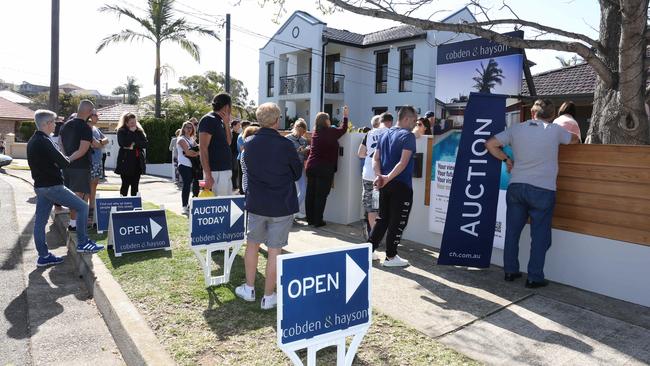House prices will keep rising ... and this is why
The 2019 federal election marked the low for housing but if recent gains continue, prices will soon hit a record high.

Five years ago in these pages I warned of an eventual fall in property prices — and significantly for apartments. Apartment buyers who didn’t heed those warnings now make up a significant portion of the 22 per cent of apartments being sold at a loss, according to CoreLogic.
READ MORE: James Kirby — What if interest rates stop going down? | Know when to fold ’em: what investors can learn from poker players | Scariest number in the housing market | Where the hidden rich live
More recently, I rang the bell that prices were approaching a low. In conversations with investors, I have explained that waiting for a low in prices is a fool’s game, with lower listing volumes ensuring investors will be chasing prices higher.
And that now appears to be transpiring, with little to get in the way of house prices continuing their rise.
The 2019 federal election marked the low for house prices. Indeed, if we annualise the past three months of house price gains, and they continue at present rates, national average house prices will hit a record high by mid 2020. That’s not a forecast, just an observation.
Two possible setbacks for property prices are a sustained rise in bond interest rates or a domestic economic rout, triggering widespread job losses.
Looking at bond rates first, it’s important to understand their effect on asset values is the same as gravity’s effect on earth. The higher they go, the more downward force they exert on values and prices.
And that inverse relationship is as true for property and equities as it is for bonds. Recall when US 10-year treasury bond rates reached 3.26 per cent in October 2018; equity markets subsequently fell nearly 10 per cent. Since those recent highs, however, US 10-year treasury bond rates have fallen to a low of just 1.44 per cent in August this year. Since August, they have bounced again to sit at nearly 2 per cent.
What happens next for bond prices will have ramifications for asset prices. If, for example, global growth surprises on the upside — especially in the US — or if Donald Trump and Xi Jinping reach a truce, or if Brexit is resolved, we could see sentiment shift to enthusiastic. Initially, the positive sentiment towards economic growth would be rocket fuel for asset prices, but if sustained it would be followed by increases in bond rates. At some point, asset prices would reverse amid a “risk-off” wave that could permeate all asset classes and geographies.
I’m not brave enough to forecast the outcome of tariff negotiations nor the outcome of Brexit, but what I do know is that any positive shift in direction for the global economy could make recent asset price increases, including real estate, seem benign.
For domestic property prices, factors other than bond rates play a role. In the short run, credit availability is arguably the most important. Fortunately for property owners (less so for those looking to buy), three rate cuts and the loosening of restrictions on mortgage approvals, particularly the abolishment of the near-7 per cent serviceability floor, has been a positive. Consequently, the value of new home loan approvals has been rising. In September, new loan approvals rose 1.3 per cent over August. It was the fourth monthly increase.
An internal examination of the Australian economy and my conversation with the RBA confirm that short-term rates are unlikely to rise soon. Faster inflation is a prerequisite for short-term rates to rise, and with wages growing at about 2 per cent — thanks partly to low inflation expectations — it’s difficult to see how inflation could threaten the 2 per cent threshold required for the RBA to act. And in its November statement on monetary policy, the RBA reduced its wage growth forecast. Core inflation expectations also remain below 2 per cent.
A slump in residential construction activity triggering tradie job losses could put marginal pressure on house prices. But then, of course, rates would remain low, and those with jobs and/or those incentivised by state and federal government programs to buy their first home, could provide offsetting support.
The latest dwelling approvals data from the Bureau of Statistics show that unit and apartment approvals are now 54 per cent lower than their June 2016 peak levels.
In the last year alone, approvals have fallen 31 per cent. This will lead to a fall in construction activity, which in turn could lead to lower retail consumption and potentially the loss of retail jobs.
But households have been keeping up mortgage payments and paying down their mortgages faster as rates have fallen.
This provides a buffer should the economy slow, and the buffer keeps households from being forced to sell. Another positive for property prices.
Consequently, there is limited housing stock on the market available for purchase. New home listings in Sydney and Melbourne are down year-on-year 10.1 per cent and 16.2 per cent respectively. Clearance rates rise thanks to rising prices.
Today, neither a domestic economic armageddon scenario nor a rapidly accelerating global growth scenario appear imminent and, combined with total house finance commitments rising 1.3 per cent in September, we can predict house prices to keep rising.
New information can change this forecast overnight, but property is a very long duration asset and a population that will double well before the official forecast of 2066 will ensure investors don’t have to wait 47 years to make a profit.
Roger Montgomery is founder and chief investment officer of the Montgomery Fund.




I think it’s fair to say I’ve got the pathway of property prices over the years.